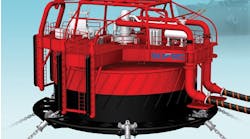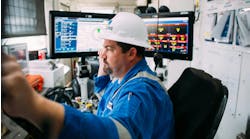Top drives are required in new and refitted drilling units around the world, and the selection of or conversion to alternating current (AC) from direction current (DC) systems is a significant issue in that selection process. Varco Systems' Marketing Manager, Phil Vollands, recently discussed the state of top drive systems and new challenges facing the top drive market.
The following is a summary of that interview:
OFFSHORE: What percentage of Varco top drive systems now available are AC powered; what percent are being retrofitted from DC power? Is the need for an AC powered top drive an important issue with operators?
VARCO: We have manufactured approximately 650 top drives of which 100, 15% to date, have been AC powered. However, in the last three years, the percentage of AC powered top drives ordered has averaged 41%, and continues to grow annually.
As far as the operators go, Varco's experience shows that the new projects such as newbuilds and major upgrades use predominantly AC technology. Land rig operations also primarily use AC top drives. Existing rigs such as jackups and semisubmersibles tend to stick to DC as the rig crew is used to the technology and the installation is made easier utilizing the rig SCR's (silicon control rectifier's).
OFFSHORE: Can you describe the issues to be dealt with for retrofitting DC to AC systems?
VARCO: Varco offers a range of upgrades to the TDS-3/3H/4/4H in terms of both capacity and performance. Typical DC to AC conversion would include modifying the motor housing assembly and guide dollies, providing a new AC motor, gearbox, and cooling system, and providing an AC variable frequency drive package. This package includes the hardware and software necessary to convert incoming three-phase AC power for precise control of the Top Drive.
OFFSHORE: What are the advantages of AC powered systems?
VARCO: The AC motors can provide far more 'bang for your buck.' AC motors essentially have the same dimensional envelope as the DC motor, but has higher torque and faster rpm capability. A second advantage is the ability to stall the AC motor at maximum torque for an indefinite period of time. The DC motor is sure to burn up after several seconds. From a maintenance and safety standpoint, the AC motor is preferred because of carbon build-up on DC motor brushes.
OFFSHORE: What engineering issues are being addressed for deeper water depth operation?
VARCO: The three principle engineering issues are flow capacity, pressure capability, and hoisting capacity. There is a limit for the hoisting requirements of the top drive, which essentially is the hookload when running the intermediate casing string. During riser running operations, the top drive can be 'parked' in a matter of minutes out of the critical path allowing the hookloads to now exceed the hoisting capacity of the top drive. During this time, routine maintenance can be performed on the top drive which maintains optimum performance and increases the working life of the machine.
OFFSHORE: Can you describe Varco's engineer ing solution to automated, integrated control systems?
VARCO: An efficient, well-conceived rig design is essential for maximum productivity, safety, and cost effectiveness. With this in mind, Varco works with customers to develop a detailed rig floor layout, which most efficiently meets the operational goals. The design process is very much a partnership with our customer. When new concepts are generated, animations are created to better explain the critical operations.




